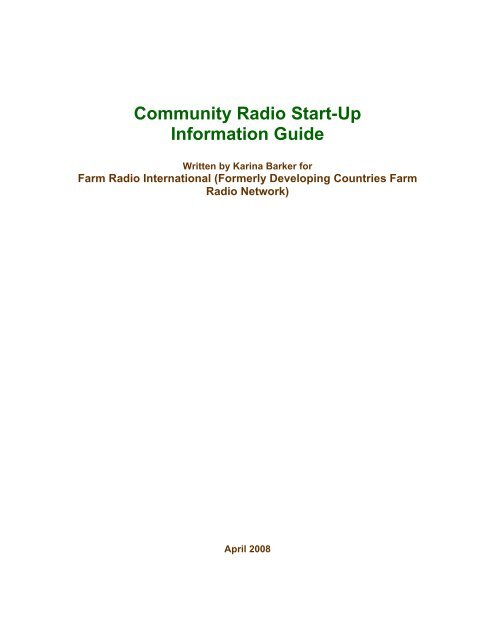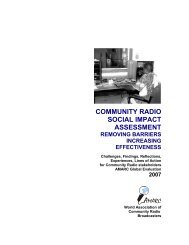Community Radio Start-Up Information Guide - amarc
Community Radio Start-Up Information Guide - amarc
Community Radio Start-Up Information Guide - amarc
- No tags were found...
Create successful ePaper yourself
Turn your PDF publications into a flip-book with our unique Google optimized e-Paper software.
TABLE OF CONTENTSINTRODUCTION................................................................................ 3SETTING UP A COMMUNITY RADIO STATION.............................. 41) Getting <strong>Start</strong>ed .......................................................................... 42) Legal Issues............................................................................... 63) Funding Options ....................................................................... 74) Selecting Equipment................................................................. 85) Managing a <strong>Community</strong> <strong>Radio</strong> Station.................................. 106) Broadcasting ........................................................................... 10CONCLUSION ................................................................................. 12REFERENCES................................................................................. 132
INTRODUCTION“A community radio station is one that is operated in the community, for thecommunity, about the community and by the community” (Tabing 2002: 11)A community radio station can be a powerful tool for addressing social concerns andpromoting social change in a community. A community radio station is defined as onethat is:• not for profit,• has community ownership and control,• and has community participation (http://africa.<strong>amarc</strong>.org).This guide is meant to be used as a tool for those interested in starting a communityradio station. Setting up a community radio station may at first seem overwhelming, butwith the right resources, and with community support, it can be a rewarding experience.This guide has two main goals:1) To provide a general overview of some of the steps that are involved in startingup a community radio station. This manual discusses how to get started, legalissues, funding options, things to think about when selecting equipment, ideas formanaging your community radio station, and broadcasting tips;2) To provide links to websites, publications and other resources that may be usefulwhen starting up a community radio station.It is important to note that there is no ‘right way’ of setting up and managing a communityradio station. This guide should not be seen as presenting the ‘only way to docommunity radio’, but rather should be seen as a tool that can be used to findinformation, ideas and case studies to help you develop a community radio station thatsuits your community’s specific needs and desires.In addition, it should be noted that this guide is not exhaustive. It simply touches onsome of the resources that are available to help you set up a community radio station.For more links and resources regarding community radio in general, consult DCFRN’swebsite, in English, at: http://www.farmradio.org/english/links.asp, or in French at:http://www.farmradio.org/francais/links.asp3
SETTING UP A COMMUNITY RADIO STATIONSetting up a community radio station can seem complicated and intimidating. However,there is a lot of information and resources available to guide you and your communitythrough this process. This section will help you find some of that information.This manual is divided into six steps:• Getting <strong>Start</strong>ed• Legal Considerations,• Funding Options,• Selecting Equipment,• Managing a <strong>Community</strong> <strong>Radio</strong> Station,• and Broadcasting.This guide briefly explains the significance of each of these steps and then points towhere you can look to find additional information. Again, it is important to note that thesesteps may differ for each community so you should adapt them to fit your community’sspecific needs.1) Getting <strong>Start</strong>edA good place to start, when considering a community radio station, is to read a generalcommunity radio guide or handbook. These handbooks provide good overviews of someof the processes involved in setting up and managing a community radio station, andoften offer tips for broadcasting. Many are quite long and detailed, and some providechecklists. Here are some suggestions of general community radio handbooks that maybe useful: How to Do <strong>Community</strong> <strong>Radio</strong>: A Primer for <strong>Community</strong> <strong>Radio</strong> OperatorsBy Louie Tabing, 2002This lengthy handbook is divided into five chapters: Concept and Practice of <strong>Community</strong><strong>Radio</strong>, Equipment, The <strong>Community</strong> <strong>Radio</strong> Council (CRC), Ethics and Code of Conduct,Managing Finances, and Securing a Broadcast License. These five chapters are thenfollowed by a section called <strong>Community</strong> <strong>Radio</strong> Programming.This handbook is very detailed, especially in terms of programming. Although it does notprovide many case studies, it does raise awareness about many things you should thinkabout when developing a community radio station.This document can be accessed in English at:http://portal.unesco.org/ci/en/files/17593/11014593681Com_radio.pdf/Com_radio.pdf <strong>Community</strong> <strong>Radio</strong> HandbookBy Colin Fraser and Sonia Restrepo Estrada, 2001This guide is divided into eight sections: <strong>Community</strong> <strong>Radio</strong> in the Broadcasting Scene,Features and Functions of <strong>Community</strong> <strong>Radio</strong>, Legal Aspects, Technical Aspects, Getting<strong>Start</strong>ed, Program Policies, The <strong>Community</strong> Broadcaster and Case Studies.4
This guide provides a detailed description of the steps involved in setting up a communityradio station, and provides case studies from around the world. The chapter titled ‘TechnicalAspects’ may be of particular interest since it goes into great detail about equipment optionsand set up, and provides a list of recommended equipment. This is useful for those who arenew to community radio. In addition, on page 54-55 there is a box called Main Factors toConsider When Planning a <strong>Community</strong> <strong>Radio</strong> Station which has a list of important questionsto ask yourself in the early planning stages.This document can be accessed in English at:http://www.unesco.org/webworld/publications/community_radio_handbook.pdf <strong>Community</strong> <strong>Radio</strong> – The People’s VoiceEd. John Van Zyl, 2003Although this community radio handbook was written for a South African audience, much ofits content can be adapted to fit other countries. This handbook is divided into six chapters:What is <strong>Community</strong> <strong>Radio</strong>?, Why human rights are essential, Managing a <strong>Community</strong> <strong>Radio</strong>Station, What <strong>Community</strong> <strong>Radio</strong> Journalism Involves, Why production is the heart and soul ofcommunity radio!, and How to make your community radio station self-sustainable.One important feature of this handbook is its checklists. This handbook provides checklists tohelp you every step of the way and has a summary checklist on page 27 that can bephotocopied.This document can be accessed in English at:http://www.abculwazi.org.za/jsp/ABC_Ulwazi.jspThe African <strong>Community</strong> <strong>Radio</strong> Manager’s HandbookAMARC Africa“Across Africa, more and more people are becoming excited about this thing calledcommunity radio. The problem has always been trying to explain it in a way that makessense to people, wherever they live. The handbook is meant to describe the process ofcommunity radio as precisely as possible” (AMARC Africa,http://africa.<strong>amarc</strong>.org/index.php?p=home&l=EN)This handbook provides particularly useful information about obtaining support from yourcommunity and government, and offers suggestions for fundraising.This document can be accessed in English at:http://africa.<strong>amarc</strong>.org/files/African_CR_Hanbook.pdfPrometheus’ <strong>Guide</strong> to <strong>Radio</strong>!This guide is a collection of links to other documents. It features a beginner’s guide to radio,a technical handbook, and tips about audio production and broadcasting. Although this guideis written for an American audience, some of the information may be adapted to fit thesituation in your community.This guide can be accessed in English at http://prometheusradio.org/content/view/193/145/A Passion for <strong>Radio</strong>: <strong>Radio</strong> Waves and <strong>Community</strong>Ed. Bruce Girard, 19925
http://www.wantokent.com/). To achieve this, WANTOK produces ‘suitcase radios’, whichare complete radio broadcast systems contained in a single case. These suitcase radios canbe purchased from their website at a low cost.WANTOK’s website can be located in English at: http://www.wantokent.com/And in French at: http://www.wantokent.com/frindex.htmHang ‘em High: Options for antennas, masts and towersBy Prometheus <strong>Radio</strong> ProjectThis guide outlines the differences between antennas, masts and towers and providesinstructions on how to assemble each option. In addition, it provides links for furtherinformation and distributors. Although it is written for an American audience, some of theinformation may be adapted to fit your community.This document can be accessed in English at:http://prometheusradio.org/content/view/194/145/Some basic electronics for radioBy Prometheus <strong>Radio</strong> ProjectThis document defines words such as ‘charge’, ‘current’, ‘voltage’ and ‘power’. In addition, itdescribes what exactly electricity is and how a circuit operates.This document can be accessed in English at:http://www.prometheusradio.org/media/pdf/electronics_basics.pdf<strong>Radio</strong>Active<strong>Radio</strong>Active is an organization based out of the United Kingdom that supports communityradio stations by providing technical planning, design and installation of radio station studioequipment, transmission systems and solar panels. In addition, they offer technical trainingcourses, technical support and maintenance.To find out more information about the services offered by <strong>Radio</strong>Active, visit their website inEnglish or Spanish at: http://www.radioactive.org.uk/OneWorldOneWorld <strong>Radio</strong>’s website has a section on training, which provides links to variousorganizations and publication regarding radio training. Their section on community radio maybe of particular interest, especially their technical tips and tricks section. This section giveslinks to information about using minidisk players and microphones.This information can be accessed in English at:http://radio.oneworld.net/section/training/radioFirst Voice InternationalFirst Voice International is an organization that, amongst other things, integrates satelliteradio with community radio. Satellite radio is a relatively new technology that can open upopportunities for community radio stations.For more information on First Voice International’s community radio projects, visit theirwebsite, in English, at: http://www.firstvoiceint.org/9
APC’s website can be accessed in English at: http://apc.org/english/about/index.shtml Step by Step: a guide to radio browsingBy UNESCO‘<strong>Radio</strong> Browsing of the Internet’ is a type of interactive program in which radio broadcastersrespond to their listeners’ questions by providing information from reliable Internet sites, CD-ROMS or other digital resources over the radio. This guide outlines the steps that should betaken to develop an effective radio-browsing program.This guide can be accessed in English at: http://portal.unesco.org/ci/en/ev.php-URL_ID=5590&URL_DO=DO_TOPIC&URL_SECTION=201.htmlAnd in French at: http://portal.unesco.org/ci/fr/ev.php-URL_ID=5590&URL_DO=DO_TOPIC&URL_SECTION=201.html <strong>Radio</strong> BrowsingBy Branislava MilosevicThis radio browsing training module provides step-by-step lessons on how to produce a radioprogram using the radio browsing of the internet format.This training module can be accessed in English at:http://www.itrainonline.org/itrainonline/mmtk/radiobrowsing.shtml OneWorld <strong>Radio</strong>OneWorld <strong>Radio</strong> is an organization that shares programs related to development. OneWorld<strong>Radio</strong> has a tool called the ‘Audio Exchange’ where members can download radio programsand re-broadcast them on their radio stations. Members can also upload programs to sharewith other members.The ‘Audio Exchange’ network can be accessed in English at:http://radio.oneworld.net/section/audioOr, in French at: http://fr.radio.oneworld.net/section/radio_fr/audioCONCLUSION<strong>Community</strong> radio is becoming a popular choice of mass media in many countries.Although developing a community radio station involves a lot of hard work and thededication of many individuals, it can be a powerful tool for addressing social concernsand promoting development within a community. With the right information and the rightpeople, community radio can be fun, exciting, and rewarding. We hope that this guidehas been helpful in locating useful information regarding the set-up of a community radiostation.Finally, we wish you the best of luck and we hope that your community radio stationbrings you and your community many rewards!12
REFERENCESFraser, Colin & Sonia Restrepo Estrada (2002). <strong>Community</strong> <strong>Radio</strong> Handbook. UNESCO.Tabing, Louie (2002). How to Do <strong>Community</strong> <strong>Radio</strong>: A Primer for <strong>Community</strong> <strong>Radio</strong> Operators.UNESCO.WANTOK. http://www.wantokent.com/ Accessed on 30 March 2007.World Association of <strong>Community</strong> Broadcasters (AMARC). http://africa.<strong>amarc</strong>.org/ Accessed on 17March 2007.13
















